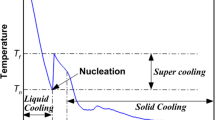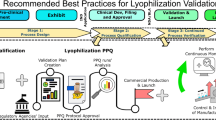Abstract
Modeling of the lyophilization process, based on the steady-state heat and mass transfer, is a useful tool in understanding and optimizing of the process, developing an operating design space following the quality-by-design principle, and justifying occasional process deviations during routine manufacturing. The steady-state model relies on two critical parameters, namely, the vial heat transfer coefficient, Kv, and the cake resistance, Rp. The classical gravimetric method used to measure Kv is tedious, time- and resource-consuming, and can be challenging and costly for commercial scale dryers. This study proposes a new approach to extract both Kv and Rp directly from an experimental run (e.g., temperature and Pirani profiles). The new methodology is demonstrated using 5% w/v mannitol model system. The values of Kv obtained using this method are comparable to those measured using the classic gravimetric method. Application of the proposed approach to process scale-up and technology transfer is illustrated using a case study. The new approach makes the steady-state model a simple and reliable tool for model parameterization, thus maximizes its capability and is particularly beneficial for transfer products from lab/pilot to commercial manufacturing.












Similar content being viewed by others
References
Karel M. Heat and mass transfer in freeze drying. In: Goldblithm SA, Rey L, Rothmayr WW, editors. Freeze drying and advanced food technology. New York: Academic Press; 1975. p. 177–202.
Liapis AI, Bruttini R. A theory for the primary and secondary drying stages of the freeze-drying of pharmaceutical crystalline and amorphous solutes: comparison between experimental data and theory. Sep Technol. 1994;4:144–55.
Liapis AI, Bruttini R. Freeze-drying of pharmaceutical crystalline and amorphous solutes in vials: dynamic multi-dimensional models of the primary and secondary drying stages and qualitative features of the moving interface. Dry Technol. 1995;13:43–72.
Kuu W-Y, McShane J, Wong J. Determination of mass transfer coefficients during freeze drying using modeling and parameter estimation techniques. Int J Pharm. 1995;124:241–52.
Kuu WY, Hardwick LM, Akers MJ. Rapid determination of dry layer mass transfer resistance for various pharmaceutical formulations during primary drying using product temperature profiles. Int J Pharm. 2006;313:99–113.
Schoen MP, Braxton BK, Gatlin LA, Jefferis RP III. A simulation model for the primary drying phase of the freeze-drying cycle. Int J Pharm. 1995;114:159–70.
Barresi AA, Pisano R, Fissore D, Rasetto V, Velardi SA, Vallan A, et al. Monitoring of the primary drying of a lyophilization process in vials. Chem Eng Process. 2009;48:408–23.
Pikal MJ, Shah S, Senior D, Lang JE. Physical chemistry of freeze-drying: measurement of sublimation rates for frozen aqueous solutions by a microbalance technique. J Pharm Sci. 1983;72:635–50.
Pikal MJ, Roy ML, Shah S. Mass and heat transfer in vial freeze-drying of pharmaceuticals: role of the vial. J Pharm Sci. 1984;73:1224–37.
Pikal MJ. Use of laboratory data in freeze drying process design: heat and mass transfer coefficients and computer simulation of freeze drying. J Parenter Sci Technol. 1985;39:115–39.
Pikal MJ, Cardon S, Bhugra C, Jameel F, Rambhatla S, Mascarenhas WJ, et al. The nonsteady state modeling of freeze drying: in-process product temperature and moisture content mapping and pharmaceutical product quality applications. Pharm Dev Technol. 2005;10:17–32.
Sheehan P, Liapis AI. Modeling of the primary and secondary drying stages of the freeze drying of pharmaceutical products in vials: numerical results obtained from the solution of a dynamic and spatially multi-dimensional lyophilization model for different operational policies. Biotechnol Bioeng. 1998;60:712–28.
Trelea IC, Fonseca F, Passot S. Dynamic modeling of the secondary drying stage of freeze drying reveals distinct desorption kinetics for bound water. Dry Technol. 2016;34:335–45.
Sahni EK, Pikal MJ. Modeling the secondary drying stage of freeze drying: development and validation of an excel-based model. J Pharm Sci. 2017;106:779–91.
Fissore D, Pisano R, Barresi AA. On the use of temperature measurement to monitor a freeze-drying process for pharmaceuticals. In: 2017 IEEE International Instrumentation and Measurement Technology Conference (I2MTC); 2017. p. 1–6.
Bosca S, Barresi AA, Fissore D. Design of a robust soft-sensor to monitor in-line a freeze-drying process. Dry Technol. 2015;33:1039–50.
Awotwe-Otoo D, Agarabi C, Read EK, Lute S, Brorson KA, Khan MA, et al. Impact of controlled ice nucleation on process performance and quality attributes of a lyophilized monoclonal antibody. In. Int J Pharm. 2013;450:70–8.
Geidobler R, Winter G. Controlled ice nucleation in the field of freeze-drying: fundamentals and technology review. Eur J Pharm Biopharm. 2013;85:214–22.
Gieseler H, Kessler WJ, Finson M, Davis SJ, Mulhall PA, Bons V, et al. Evaluation of tunable diode laser absorption spectroscopy for in-process water vapor mass flux measurements during freeze drying. J Pharm Sci. 2007;96:1776–93.
Kuu WY, Nail SL, Sacha G. Rapid determination of vial heat transfer parameters using tunable diode laser absorption spectroscopy (TDLAS) in response to step-changes in pressure set-point during freeze-drying. J Pharm Sci. 2009;98:1136–54.
Pikal MJ, Bogner R, Mudhivarthi V, Sharma P, Sane P. Freeze-drying process development and scale-up: scale-up of edge vial versus center vial heat transfer coefficients, Kv. J Pharm Sci. 2016;105:3333–43.
Rambhatla S, Pikal MJ. Heat and mass transfer scale-up issues during freeze-drying, I: atypical radiation and the edge vial effect. AAPS PharmSciTech. 2003;4:Article 14.
Tang X, Nail SL, Pikal MJ. Freeze-drying process design by manometric temperature measurement: design of a smart freeze-dryer. Pharm Res. 2005;22:685–700.
Pikal MJ, Pande P, Bogner R, Sane P, Mudhivarthi V, Sharma P. Impact of natural variations in freeze-drying parameters on product temperature history: application of quasi steady-state heat and mass transfer and simple statistics. AAPS PharmSciTech. 2018;19:2828–42.
Wegiel LA, Ferris SJ, Nail SL. Experimental aspects of measuring the vial heat transfer coefficient in pharmaceutical freeze-drying. AAPS PharmSciTech. 2018;19:1810–7.
Patel SM, Doen T, Pikal MJ. Determination of end point of primary drying in freeze-drying process control. AAPS PharmSciTech. 2010;11:73–84.
Roy ML, Pikal MJ. Process control in freeze drying: determination of the end point of sublimation drying by an electronic moisture sensor. J Parenter Sci Technol. 1989;43:60–6.
Bardat A, Biguet J, Chatenet E, Courteille F. Moisture measurement: a new method for monitoring freeze-drying cycles. J Parenter Sci Technol. 1993;47:293–9.
Nail S, Johnson W. Methodology for in-process determination of residual water in freeze-dried products. Dev Biol Stand. 1992;74:137–51.
Milton N, Pikal MJ, Roy ML, Nail SL. Evaluation of manometric temperature measurement as a method of monitoring product temperature during lyophilization. PDA J Pharm Sci Technol. 1997;51:7–16.
Tang X, Nail SL, Pikal MJ. Evaluation of manometric temperature measurement, a process analytical technology tool for freeze-drying: part I, product temperature measurement. AAPS PharmSciTech. 2006;7:E14.
Tang XC, Nail SL, Pikal MJ. Evaluation of manometric temperature measurement (MTM), a process analytical technology tool in freeze drying, part III: heat and mass transfer measurement. AAPS PharmSciTech. 2006;7:97.
Tang XC, Nail SL, Pikal MJ. Evaluation of manometric temperature measurement, a process analytical technology tool for freeze-drying: part II measurement of dry-layer resistance. AAPS PharmSciTech. 2006;7:93.
Christ M. Smart freeze drying-basic principles, optimum procedures and applications. 2010. Available from: https://www.martinchrist.de/fileadmin/user_upload/christ/04_anwendungen/lyophilisation/Smart_FD_Basics_Apps_en.pdf. Accessed 30 Jan 2019.
Patel SM, Jameel F, Pikal MJ. The effect of dryer load on freeze drying process design. J Pharm Sci. 2010;99:4363–79.
Patel SM, Pikal MJ. Freeze-drying in novel container system: characterization of heat and mass transfer in glass syringes. J Pharm Sci. 2010;99:3188–204.
Tchessalov S, Dixon D, Warne N. Principles of lyophilization cycle scale-up. Am Pharm Rev. 2007;10:88–92.
Zhu T, Moussa EM, Witting M, Zhou D, Sinha K, Hirth M, et al. Predictive models of lyophilization process for development, scale-up/tech transfer and manufacturing. Eur J Pharm Biopharm. 2018;128:363–78.
Funding
This study was funded by AbbVie Inc. AbbVie is responsible for the study design, research, data collection, analyses, and interpretation of data, as well as writing, reviewing, and approving the publication.
Author information
Authors and Affiliations
Corresponding author
Ethics declarations
Conflict of Interest
All authors are AbbVie employees and may own AbbVie stock.
Additional information
Publisher’s Note
Springer Nature remains neutral with regard to jurisdictional claims in published maps and institutional affiliations.
Rights and permissions
About this article
Cite this article
Zhou, D., Shang, S., Tharp, T. et al. Leveraging Lyophilization Modeling for Reliable Development, Scale-up and Technology Transfer. AAPS PharmSciTech 20, 263 (2019). https://doi.org/10.1208/s12249-019-1478-9
Received:
Accepted:
Published:
DOI: https://doi.org/10.1208/s12249-019-1478-9




